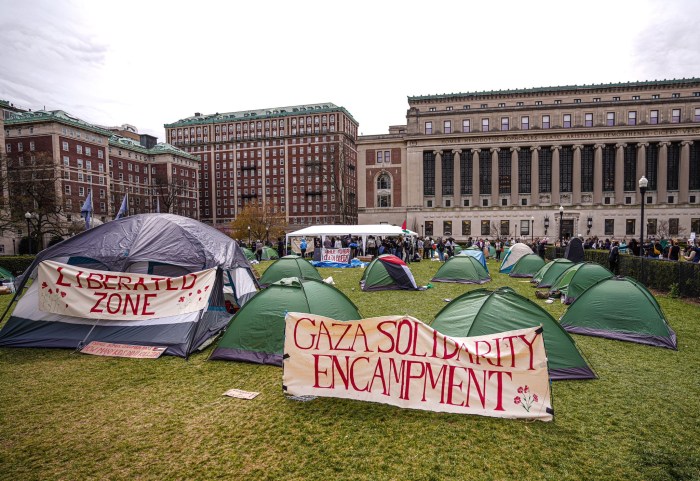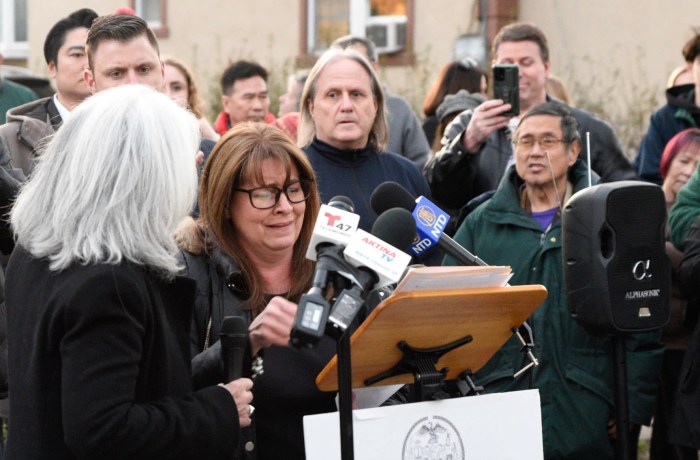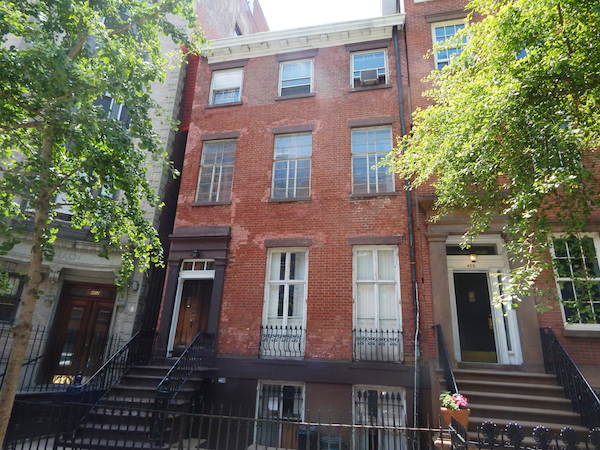
BY SEAN EGAN | Who can truly lay claim to pride of ownership, when it comes to what is widely regarded as the oldest house in Chelsea: those who say its structural and historical integrity must be preserved, or the person who bought it for $7.4 million and wants to make extensive renovations?
Built in 1830 and purchased in 2015 by British banker Ajoy Veer Kapoor, the home at 404 W. 20th St. (btw. Ninth & 10th Aves.) sits within the Cushman Row of the Chelsea Historic District, making any attempts at alteration subject to review by the city’s Landmarks Preservation Commission (LPC). The renovations, which would significantly increase the size of the house, would require most of the original house to be destroyed in the process, as the new owner attests that the house is structurally unsound.
Prior to the proposal’s public hearing before the LPC this past April, Community Board 4 (CB4) spoke out against the expansion effort, penning a letter to the LPC urging them to reject a proposal that “would demolish the entire house except for its street facade, and do further violence to this house and to the most historically sensitive and architecturally distinguished block in Chelsea.”
While the owner is currently developing new plans after receiving feedback from the LPC on their proposal, locals and preservationists staunch in their opposition are continuing to draw attention to the situation. To this end, Save Chelsea, a local preservationist organization, staged a rally against the renovations on Sat., June 4.
![A House Divided: Community Debates Fate of 404 W. 20th St. 2 At the rally, Mary Swartz of Save Chelsea urged “the LPC [to] reject the wholly inappropriate plans” for 404 W. 20th St., and read a statement of opposition from State Senator Brad Hoylman. Photo by Sean Egan.](https://www.amny.com/wp-content/uploads/2016/06/June9_House_Mary.jpg)
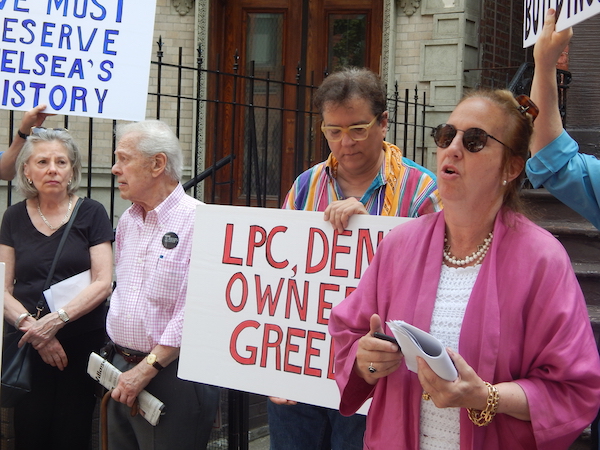
PRESERVATIONISTS GIVE LANDMARKS A FAILING GRADE | The LPC, in general, was also heavily criticized in its perceived shortcomings in protecting the landmarks they ostensibly exist to protect, both in this instance and numerous others throughout the city — such as the Hopper-Gibbons House, whose 339 W. 29th St. location puts it in the Lamartine Place Historic District, and whose owner has been in a years-long dispute over his construction of a fifth floor.
Manhattan Borough President Gale Brewer was on hand at the June 4 rally to decry the LPC’s lax record of following their own laws. “[LPC] need to follow Landmarks Law to the N-th degree,” said Brewer. “Otherwise why do you have the law?”
“LPC is supposed to be a check on unmitigated greed,” District 3 City Councilmember Cory Johnson elaborated, commenting on the renovations, as well as the trend of developers trying to alter landmarked structures in the community. “It’s our job to stand up for it.”
Assemblymember Richard Gottfried noted that it was the neighborhood and community that gave the house its value, and that it was “profoundly wrong [of the owner] to benefit from the value of the community by trashing that value.” Representatives from the offices of State Assemblymember Richard Gottfried and State Senator Brad Hoylman were also present.
HOW DID 404 FALL INTO DISREPAIR, AND HOW EXTENSIVE ARE THE DESIRED CHANGES? | Andrew Berman, Executive Director of the Greenwich Village Society for Historic Preservation, expressed a commonly held belief amongst the group that the structural problems the new owner is grappling with at 404 W. 20th St. are “bogus or self-created, or both” — specifically due to flooding caused by a burst water pipe in February 2016 because the unoccupied house was not heated.
“[404 W. 20th St.] is exactly what LPC exists to protect,” Berman said, noting that such benign neglect is all the more reason buildings of historic value are in such desperate need of protection. “I think we need to draw a line in the sand,” he declared, “and I think this is the perfect place to do it.”
For their part, the owner and his representatives refute most of the arguments of Save Chelsea and their supporters. On the repeated allegations that the owner would be adding floors and expanding the basement along nearly the whole length and width of the property, both Shawn Felker, a close family friend of the Kapoors, and Michele de Milly, a Principal at Geto & de Milly, Inc., the public affairs firm representing Kapoor, attest that the owner’s revised design plan would not add any upper floors, and would maintain the house’s pitched roof.
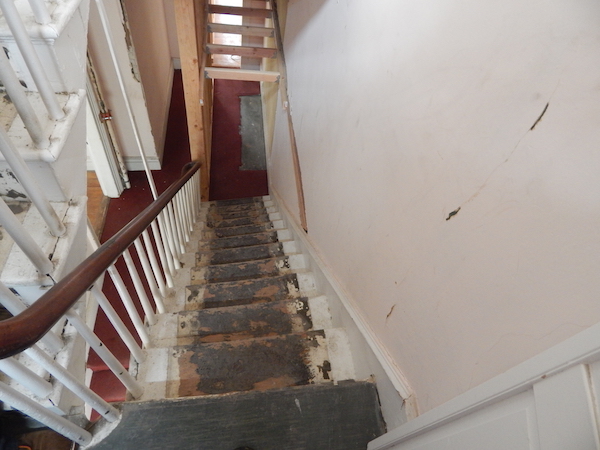
Felker, who also brokered the house’s $7.4 million sale for Kapoor, reported that the addition would only expand back as far as the neighboring building at 402 W. 20th St. does, also consistent with a number of other buildings on the block — and that the proposed basement would not span “almost the length and width of the entire property” as Save Chelsea asserted in a June 4 press release, but instead about half the yard. In addition, the façade of the building would receive a complete restoration, and “elements like original fireplaces will be retained, restored and reinstated,” according to a statement from William Suk, the project’s architect. “Anything that can be saved, will be saved,” furthered Felker.
These plans represent a significant scale back from the initial (and thus far only) plans presented to CB4 and the LPC, and take into consideration the feedback given by that organization and the community, explained de Milly. While these new designs were not readily available at press time, de Milly confirmed that they would be available to the public “shortly” after their forthcoming submission to the LPC.
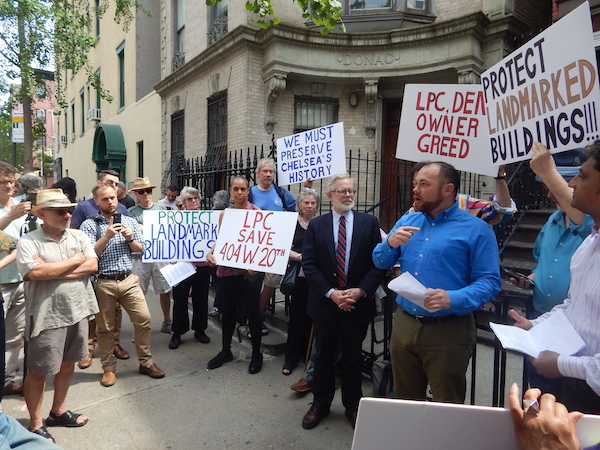
LAYING BLAME AT THE DOORSTEP OF BUYER — AND SELLER | Felker also took umbrage at comments from electeds and preservationists at the rally indicating the plans reflect greed on behalf of the owner, noting that this case is dissimilar to other situations involving the LPC and developers in Chelsea. He maintains that Kapoor plans on keeping the house a four-bedroom single-family home for him, his elderly mother, wife, and school-age son, rather than trying to turn a profit from the house.
“Mr. Kapoor is not adding a floor, and he’s certainly not renting out any portion of this house ever,” said Felker. “They’re not trying to add any kind of rental component to this house whatsoever. So there’s no greed. He’s buying a house he’s going to renovate and move into, so I just don’t understand the greed component.”
Felker also insists that the flooding caused by the burst pipe was never the impetus behind the renovations, and that its impact on the home was minimal. Long-term neglect on behalf of the previous owners was the cause of the structural damage sustained to the house, not the flooding, he insists.
As evidence, Felker points to the city Department of Buildings (DOB) violations issued to the house back in September of 2015, shortly after the house’s purchase — months before the pipe burst in February — in which the DOB asserted that the building was “deteriorated,” with “sloped interior floors, tilted stairs and cracked walls” and required immediate repair. In order to address this issue, a number of wooden and metal support structures were installed throughout the home. A walking tour of the house also confirms these accounts of slanted stairs and cracked walls. This condition, to the Kapoor camp, justifies the expansive remodeling that would require a full rebuild of much of the house’s interior framing.
A number of longtime neighbors are in agreement, and have come out in support of Kapoor’s project, and have publically reiterated issues with the property prior to Kapoor’s purchase. Marion Buhagiar, the owner of 402 W. 20th St. and a former Save Chelsea member, testified at the project’s public LPC hearing, and wrote to LPC Chair Meenakshi Srinivasan. In the body of her Nov. 4, 2015 letter, Buhagiar describes having “observed the steady deterioration of the structure” for decades, and notes that she “alerted the former owners to serious breaches in the east-facing wall that faces [her] property.”
Another neighbor, Debra Guerrero (at 406 W. 20th St.) recounted past issues, including rats nesting in vegetation formerly at the site. In addition, along with Jose Antonio, she penned two letters to Srinivasan. In a June 2, 2016 letter, the couple stated that they have “strong support” for the project, and that “the most causal observer will realize the house is leaning and is badly in need of repair.”
The previous owners of the home — Lesley Doyel, recently resigned as President of Save Chelsea and current board member, and her husband, Nicholas Fritsch — refute the claims of neglect alleged by Kapoor’s reps and neighbors. While Fritsch does admit that the house “definitely needed work” and “serious renovation” — citing difficult and expensive upkeep as a motivating factor in the house’s sale — its condition was not neglected, and not so dire that it was unsalvageable and warrants the proposed demolition and expansion.
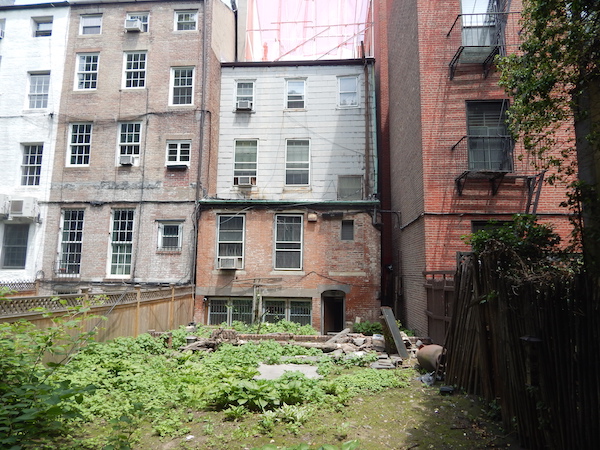
In a May 1 letter addressed to LPC Chair Srinivasan, Doyel and Fritsch — who did not organize nor attend the rally, and no longer reside in Chelsea (their home is now in Washington Heights) — firmly dismiss the accusations of neglect directed at them by Kapoor’s reps and Buhagiar. Doyel and Fritsch call the accusations a “fallacious narrative” constructed in order for the new owner to go forward with demolition, and point out that “nowhere does the [September 2015 DOB] report indicate that this property needs to be condemned or is uninhabitable, merely that structural issues must be repaired and corrected.”
In a return letter addressed to them dated May 26, 2016, John Weiss, Deputy Counsel for the LPC, wrote: “I was in your home after its sale to the current owner when it was being inspected by an engineer from the Department of Buildings. I can attest that the house was not, at the time, in a neglected state as has been alleged.”
Felker noted that no covenants or stipulations, which would limit what the owner could do with the property after purchase, were made — and speculates that the previous owners did not include any upon the sale of the house because it would have significantly lowered the price it sold for. Fritsch, however, asserts that they sold the house “as-is” without an inspector, and that its contract included all the standard stipulations about applicable Landmarks Law — which presumably would negate the need for any extra stipulations.
Kapoor and associates continue to navigate the LPC process, and Save Chelsea continues to fight against the plans. Chelsea Now will continue to follow this story.











